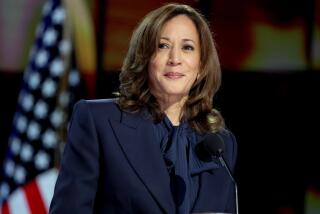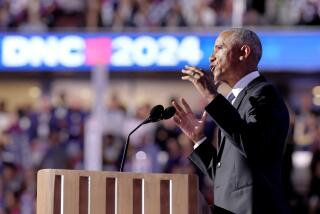COLUMN ONE : Democrats Search for an Identity : Revisionists say leaders have lost touch with the middle class. Others stick to traditional liberalism. The differences shape the debate on how to regain the White House.
Judged by all the usual signs of political vitality, the contest for the 1992 Democratic presidential nomination still barely registers a pulse.
No Democrat is stockpiling endorsements in New Hampshire or cash in California. Iowa farmers who have grown accustomed to months of slavish attention are bringing in their crop this year without help from governors and senators.
Four years ago Monday the seven Democratic contenders for the 1988 nomination had already gathered for their first nationally televised debate. At the moment, with only former Massachusetts Sen. Paul E. Tsongas officially in the race, there are not enough declared Democratic hopefuls to fill out a Ping-Pong match, much less a candidate forum.
But on one crucial front, the Democratic race is quickening. A group of potential candidates--ranging in ideology from New York Gov. Mario M. Cuomo and Iowa Sen. Tom Harkin at one end to Tennessee Sen. Albert Gore Jr. and Arkansas Gov. Bill Clinton at the other--are publicly engaged in the intellectual debate that will define the boundaries of next year’s primaries.
Seven months before Iowa Democrats will formally begin the nomination process next February, lines are already forming within the party between two contending visions of the road back to the White House--one that says the Democrats need to fundamentally change their appeal, and another that maintains the party’s problem in national campaigns has not been its message, but its messengers.
This is the kind of fissure a party can expect when it loses five of the past six national campaigns, three of them by landslides. That heavy legacy of failure--and what now seem like the long odds of overcoming it next year against President Bush--is shaping the debate now under way. After two decades of frustrating self analysis, a fundamental divide between Democrats--in some respects the fundamental divide--is over the explanation of what has gone wrong.
On one side of this division are the Democratic traditionalists, whose base is in organized labor and other national constituency groups, local activists on peace, environmental and women’s causes, and among elected liberals at both the national and local level.
These Democrats most often explain the GOP dominance of the White House either as the result of Republican success at distracting the country with “secondary” issues such as racial quotas and prison furloughs or the Democratic failure to “nominate a good progressive standard-bearer who tells it like it is,” in the words of Robert Kuttner, editor of the American Prospect, a liberal journal.
For this camp nothing that has happened in the past 25 years indicates any fundamental weakness in the modern liberal message of economic compassion and social tolerance.
Iowa Sen. Harkin, a likely entrant in the race for the nomination, unfurled their credo recently when he declared: “I believe the traditional values of the Democratic Party are fundamentally sound and have a broad based appeal to the American people.”
On the other side are the party’s revisionists, a less cohesively organized group that has primarily clustered around the Democratic Leadership Council, an organization of centrist elected officials, many from the South and West. These critics argue that Democrats have contributed to their own demise by losing touch with the basic values of the middle-class voters that anchored the New Deal coalition.
Clinton’s Summary
Arkansas Gov. Clinton, who has been considering the race, nailed their challenge on the party’s door in a speech this spring to the DLC conference in Cleveland. “Too many of the people who used to vote for us, the very burdened middle class,” he declared, “have not trusted us in national elections to defend our national interest abroad, to put their values in our social policy at home or to take their tax money and spend it with discipline.”
On these differing analyses of the problem, these two camps build different messages for the voters. Those in the party’s traditional wing--whose champions range from Harkin and New York Gov. Cuomo to the Rev. Jesse Jackson and Sen. Edward M. Kennedy (D-Mass.)--believe that the right messenger can win with a class-conscious economic appeal, a tough line in trade negotiations with foreign competitors, and uncompromised support for the agenda of the civil rights community and the other social movements that grew out of the 1960s.
Around this core of shared beliefs, each of the potential candidates for the nomination in this wing of the party add their own distinctive embellishments. Jackson stresses both racial empowerment and unvarnished anti-corporate populism. Harkin has excited liberal audiences around the country this spring with a give-’em-hell version of Midwestern populism that slams Wall Street (“What’s wrong in this country today,” he says, “is that there are too many people making money on money”), lauds organized labor, argues that the proposal to lower trade barriers with Mexico will cost blue collar jobs in the United States, and lacerates the Republicans for favoring the rich.
Cuomo, while hitting many of those same notes, has also over the past year formulated a condemnation of Washington inaction that represents the inverse of Michael S. Dukakis’ strategy in 1988. Dukakis tried to sell the public on the Massachusetts miracle; in his speeches, Cuomo paints the New York nightmare, raising New York not as a paradigm of success but as the model of national decline he blames on Washington inertia in both parties.
Break From Past
If anything, the party’s revisionist wing is even more diverse. What unites them is not a program but a critique: The one point on which they all agree is that the party will not be able to make its case about the future unless it breaks from some of its past policies, particularly on spending and social issues. As political consultant Brian Lunde, a former executive director of the Democratic National Committee puts it, “we have got to admit some mistakes or else the public isn’t going to let us move on.”
Several presidential candidates are likely to run under varying versions of that banner, each emphasizing one area where they maintain the party must repent. Tsongas has called on the Democrats to abandon “the corporate bashing, the class warfare, the anti-business instincts” and instead restructure its economic appeal around a new partnership with business.
Virginia Gov. L. Douglas Wilder has aggressively explored the race with speeches urging greater cuts in federal spending and recognition that government cannot solve all problems. From the 1988 campaign on, Tennessee Sen. Gore has exhorted Democrats to accept a more activist role for the United States in world affairs.
But the most comprehensive criticism of the traditional Democratic appeal has come from the DLC, primarily in a series of speeches Clinton, its chairman, has delivered around the country this year. Clinton has sketched a strategy for rebuilding a Democratic majority around several basic themes that do not all fit onto a liberal-conservative continuum.
At the center of the Clinton message has been a call for “Democrats . . . to reinvent government to make it work.” Among the ideas that Clinton and other moderates have forwarded under that heading are allowing parents greater choice in the selection of their children’s schools, creating national service programs that allow young people to work as teachers or police officers in return for college financial aid, stiffening child support enforcement laws, increasing tenant management of public housing projects, and crafting government programs that attempt to encourage personal responsibility.
In Arkansas, for example, Clinton recently signed legislation that denies driver’s licenses to teen-agers who drop out of high school; he has also talked approvingly of revising divorce laws to compel judges “to place more emphasis on how divorces affect the children involved” rather than “just . . . the personal desires of either parent.”
All this, says Robert J. Shapiro, vice president of the Progressive Policy Institute, a think tank associated with the DLC, represents “an attempt to take the traditional goals of the Democratic Party . . . and find means to achieve them that embody the values of the country.”
Shapiro argues that the differences between that vision and the dominant party approach are not “between left and right but rather old and new.” In fact, the divisions run along both those axes.
On domestic issues, many of the ideas advanced under the goal of reinventing government--particularly school choice and draining authority away from Washington--frighten liberals and party interest groups such as teachers unions who (accurately) see in them echoes of the conservative criticism of centralized government action.
Foreign Policy Split
On foreign policy, almost all of the traditionalists opposed the use of force against Iraq; though revisionists were divided, the bulk of Democratic congressional support for the Administration--including Gore, Virginia Sen. Charles S. Robb and Oklahoma Rep. Dave McCurdy--came from their ranks. On trade, most Democrats in the traditional wing opposed granting Bush greater leeway to negotiate a free trade agreement with Mexico; the dissenters, including Gore and Tsongas, generally supported the Administration.
The DLC insurrection has sparked the most antagonism on social issues, where some liberals accuse the critics of subtly signaling their intent to back away from the agenda of the poor and minorities. On civil rights, for example, the two sides differ on both tactics, and ultimately, goals. Almost without exception, the traditional Democrats reject any retreat from affirmative action and condemn as thinly disguised racism President Bush’s attempts to characterize the civil rights legislation now pending as a “quota bill.”
But many of the leading critics--with the exceptions of Wilder and Tsongas--have argued that Democrats must stress their own opposition to quotas, and ultimately shift the debate away from programs of racial preference toward “race-neutral” policies, such as apprenticeships for teen-agers not bound for college, that offer equal benefits to economically strained whites and blacks. “We want government to guarantee equal opportunity for all, but special privileges for none,” Rep. McCurdy told the DLC convention in May.
That kind of language infuriates liberals, who maintain that it implicitly endorses Republican accusations about the party. “Some Democrats have fallen into the trap of buying the Republican line that the Democrats’ message, what we stand for, is out of step and that we have to become more like Republicans,” Harkin bristles.
Clinton responds, “If you’ve got to be a Republican to say that work is better than welfare and people ought to pay their child support, then we’re in worse shape than I thought.”
Many Similarities
In the heat of this debate, it is easy for advocates on both sides of this divide to overstate their differences. The walls between the Democratic traditionalists and their critics are porous.
Some potential candidates do not precisely fit into either faction. By keeping his nose buried in his plans to reform the health care system, West Virginia Sen. John D. (Jay) Rockefeller IV has so far ducked this internal cross-fire. House Majority Leader Richard A. Gephardt, (D-Mo.), a politician both agile and protean, has feet in both camps. Even Clinton, who has emerged as the flash point of dissent, has long-standing ties to many of the party’s leading liberals.
Similarly, though Cuomo is the hero of those Democrats awaiting deliverance by a true liberal, he resists that label--with some justification. For all his panache with the rhetoric of economic fairness, Cuomo has presided over a substantial cut in the top income tax rate in New York, and is completing an austere state budget that provoked a protest march led by the Rev. Jackson. Cuomo’s proposals for rousing the country from recession have included a targeted capital gains tax cut that draws rave reviews from founding supply-side theorist Jude Wanniski, who enthusiastically labels the New Yorker one of the few Democrats of “presidential timber.”
By historical standards, the differences between the two Democratic camps today are not as great as others the party has bridged; they do not compare in ideological distance to the chasm between Northern liberals and Southern segregationists over civil rights that persisted for decades, or even the ferocious internal dispute over Vietnam that felled Lyndon B. Johnson.
No single issue--not even the war in Iraq--promises to be near as polarizing for the Democrats in 1992. In sharp contrast to the Republicans, Democrats head into the campaign with a virtually inviolate consensus behind ensuring freedom of choice on abortion, potentially the most divisive issue in American politics.
Democrats of all persuasions this year are stressing the related issues of middle-class squeeze, tax fairness, and rising health care costs. All Democrats are eager to accuse Bush of indifference to domestic problems. And, though they differ on means and magnitude, Democrats remain united around their belief in an activist government.
“We don’t have the kind of issues that carve us across ideological lines as we did in the 1960s,” says Democratic consultant Victor S. Kamber. “There clearly is a right to left in the party, but they are gradations. . . . “
But if the potential candidates do not conform to rigid divisions on all issues, they nonetheless present significantly different images and priorities--much the way Walter F. Mondale and Gary Hart did in 1984 despite their substantial agreement on many questions.
Different Messages
As in 1984, the key differences today are not so much over specific policies as the general message each side transmits to the voters. Liberal leaders such as Harkin, Cuomo and Jackson project a Democratic Party tied closely to its key constituency groups--organized labor, civil rights organizations, environmentalists, feminists--rooted in the industrial and agricultural states of the Northeast and Midwest, and committed to addressing social problems primarily from Washington.
Today’s internal dissenters, particularly those at the DLC, stress their independence from the interest groups--sometimes subtly, sometimes belligerently--draw their greatest strength from the South and West, and look to the states to incubate new responses to domestic needs.
Perhaps most important, each of these competing Democratic messages embodies an alternative electoral strategy; each envisions a different political coalition.
The messages emanating from the revisionist camp--fiscal prudence, a hard line on crime and defense, independence from minorities and the poor--are aimed squarely at winning back white middle-class voters. Their targets include lower-income ethnic and Southern Ronald Reagan Democrats who deserted the party during the 1980s and more upscale suburban independents who have provided Republicans with a crucial margin in national campaigns.
For Clinton, Gore, Tsongas and the other potential candidates urging a change in course, the fundamental problem is that very few of those voters participate in Democratic primaries any more. It is almost a syllogism that relatively few of the Democratic activists who do vote will be intuitively attracted to a message centered on the deficiencies of the Democratic Party.
The traditionalists, who believe the party’s salvation lies in increasing turnout among its base of lower-income and minority voters, face the opposite dilemma. Though their partisans dominate the nominating process, they no longer constitute a general electoral majority by themselves. As political analyst William Schneider pointed out after the 1988 campaign, Dukakis ran better among Democrats than Mondale or Jimmy Carter; the problem is that with so many voters now true independents, elections can no longer be won just by mobilizing the remaining Democratic coalition.
Nothing guarantees that the eventual Democratic candidates will forthrightly debate the merits of these alternative paths. Much of the primary struggle never rises above the muck of money, personality, and organization. And the contestants for the nomination typically shape their messages not only out of deep ideological conviction, but also their tactical sense of the openings in the field; they usually behave more like halfbacks than philosophers.
Still, those constraints have not always precluded fundamental debate. In 1984, Hart and Mondale--to a degree that may not have been entirely appreciated at the time--did present Democrats with two very different roads toward the future. On the other hand, in 1988, with Dukakis occupying a non-ideological middle ground that allowed both Hart and Mondale supporters to see in him what they wanted, the primaries never sharpened into a clear choice.
That could happen again, particularly if figures such as Cuomo, Jackson and Clinton, who embody these competing arguments in their purest form, sit out the race. But with the right mix of candidates, many Democrats are optimistic that next year the party can continue to refine a new synthesis for the coming decade, even if it does not unseat President Bush.
“We never finished that internal discussion from 1984,” says Lunde. “But if we get some clear lines between the candidates established the way Hart and Mondale did, we could pick up where we left off.”
More to Read
Get the L.A. Times Politics newsletter
Deeply reported insights into legislation, politics and policy from Sacramento, Washington and beyond. In your inbox three times per week.
You may occasionally receive promotional content from the Los Angeles Times.










